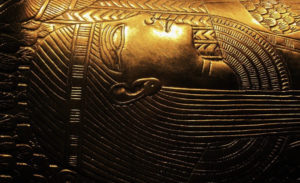
Kathlyn (Kara) Cooney proves that the value of a great scholar and speaker is timeless and priceless. A few years ago, Richard (the interviewer) met her after her lecture on ancient Egypt at One Day University in New York City. This was a poignant example of how an afternoon immersion in the land of the Nile can lead to all sorts of tributaries and surprises. Kara (pictured below) is a professor of Egyptian Art and Architecture and Chair of the Near Eastern Studies Department at UCLA. She is currently researching coffin reuse in ancient Egypt and has studied nearly 300 coffins around the world. Her two books – The Woman Who Would Be King: Hatshepsut’s Rise to Power in Ancient Egypt (Crown, 2014) and When Women Ruled the World: Six Queens of Egypt (National Geographic Press, 2018)—have been generously reviewed. In late fall 2020, National Geographic released a special edition on Kara’s work on female pharaohs.
In 2008, Kara co-wrote and produced the Discovery Channel’s Out of Egypt, an exploration of ancient cultures, architecture and the sacred, with a special emphasis on timeless, archetypal shapes: cities and civilization go hand in hand, but disease and strife are not far behind. Kara was also co-curator of Tutankhamun and the Golden Age of the Pharaohs at the Los Angeles County Museum of Art, which opened in 2005. She was also a member of the team that excavated the artisan’s village of Deir el Medina in Egypt. This interview focuses on King Tut and his remarkable parents, Akhenaten and Nefertiti. Kara is interviewed here by author and professor Richard Marranca.
_________________________________
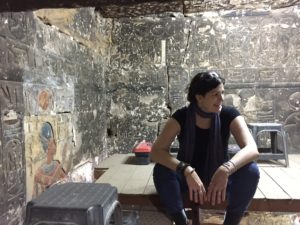
Kara Cooney onsite in Egypt. Courtesy Patina Productions
_________________________________
RM: It is exciting that you curated the Tut (Tutankhamun) exhibit in Los Angeles. Do you think Tut returned to the old gods and rejected the “monothesism” of Akhenaten on his own, or was he forced into that? Why did he abandon the new capital, Amarna, in the desert?
KC: Interestingly, our history of Tutankhamun is inseparable from our history of Nefertiti (the queen and royal wife of Pharaoah Akhenaten); more and more Egyptologists are realizing that the end of the Amarna period was being shaped by a powerful female rather than a powerful male. Tutankhamun is famous today because of his funerary material; but one of the only reasons I’m interested in his funerary material is because it’s a reflection of Nefertiti as ruler before him. And if anybody returns to the old gods and the old ways and traditions, it was Nefertiti. It was not Tutankhamun.
He was actually the beneficiary of her activities. Yes, he was born Tutankhaten and became Tutankhamun, but that likely happened before he took the throne. It probably happened when he was quite a young boy. And even when I experience my own son, who is now 10, I consider that even though Tutankhamun was brought up in the Amarna religion as a young boy, his earliest memories would have been shaped by Nefertiti, likely moving Egypt back to traditional ways, with the entire court quickly falling in line.
So the pendulum was already swinging in that direction. Whatever the ruler did after Akhenaten, I think everybody knew they needed to swing back into that direction. It doesn’t seem that Tutankhamun was raised with any protective nature towards his father’s religion. I think that’s his earliest memories, but his most formative memories as a child, starting around six, seven or eight years of age, would have been of the old religion rather than his father’s new religion.
______________________________
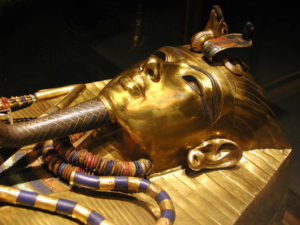
Close-up detailed view of Tutankhamun’s innermost coffin found within his tomb. Jon Bodsworth, Pubic Domain, Wikimedia Commons
______________________________
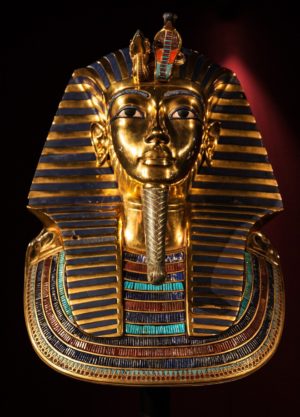
The death mask of Tutankhamun. Image by Gerhard G. from Pixabay.
______________________________
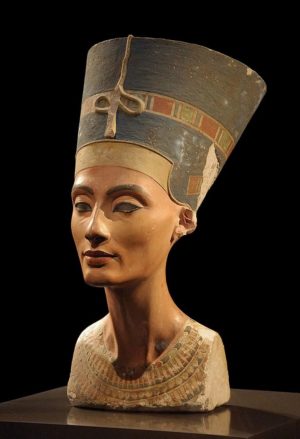
The bust of Nefertiti, exhibited at the Neues Museum. Philip Pikart, GNU Free Documentation License, Wikimedia Commons
______________________________
RM: Tut’s uncle or father Akhenaten is one of the most enigmatic figures in history. Bob Brier said that he was the first “hippie” and monotheist. Can you be a monotheist if you think you’re a god yourself? Can you tell us about him?
KC: Akhenaten may have been the father of Tutankhamun. Or he may have been the grandfather or uncle. We actually don’t really know. The lack of clarity is of itself very suspicious. Akhenaten is quite the character, and there’s been much attention on him by Egyptologists trying to figure out what made him tick and why he did what he did. Opinions are quite varied, and it’s difficult to determine the truth because of course we’ve never been able to meet the guy. He never put his thoughts into writing in a way that would allow us to understand why he did what he did. The “hippie” idea is the traditional way of looking at this guy. He implemented these great ideas, and then people didn’t like them. But there’s this hippie 1968 sort of feeling about him that he’s about peace and love and it’s an amazing time of experimentation. What is god? What is the universe? It seems all ‘poppies and rainbows’. But even hippies have a dark side. Right? There was the Summer of Love in ’69 and then things got really dark in the ‘70s. You have things like Charles Manson, Patty Hearst kidnappings and all kinds of bombs going off and revolutionary thinking — “You Say You Want a Revolution”, as the Beatles song goes. But I wouldn’t call Akhenaten a revolutionary. That’s the wrong word. A revolution comes from the grass roots of society. This is coming from the very pinnacle, from the very top, the most authoritarian regime one can possibly imagine. And I wouldn’t call him a monotheist, necessarily.
More accurately, I would say Akhenaten was likely the first fanatic. He’s the first to take religion and make it not just exclusionary, but fanatically tell people what is right and what is wrong. And when people don’t go along with what he says, there is a reaction. Here the Egyptians are not clear about what happened. But there was probably some level of coercion to what Akhenaten implemented in his country. He leaves the traditional capitals of Memphis and Thebes, funneling money away from those very archaic temple institutions. He moves them into a new direction and founds this new capital city in the middle of nowhere.
_______________________________
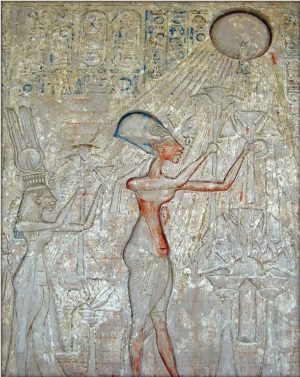
Relief of Akhenaten, Nefertiti and two daughters adoring the Aten. 18th dynasty, reign of Akhenaten. Between -1372 and -1355 BC. The Royal Tomb, Tell el-Amarna, Egypt. Photographer Jean-Pierre Dalbéra from Paris, France. Attribution 2.0 Generic license, Public Domain, Wikimedia Commons
_______________________________
RM: It was very bold and quixotic — bringing all those followers out to the desert.
KC: When he makes that move, he marshaled his main support from the army. Because it comes from the military part of society, this implies that the priests were not interested in going along with these ideas. Does that mean he is coercing the rest of the population to either get in line or not say anything against him? It’s not clear, but the Egyptian regime was always authoritarian and people never spoke against their king in a public or documented way. This wasn’t a Greek democracy or a Roman tribunal senatorial system. This was an authoritarian divine kingship and the king was not to be questioned. And so, we wouldn’t expect to see dissent clearly recorded anywhere. And so I think the best evidence that people were suffering under Akhenaten’s rule and his fanatical religious changes was the return to the old ways in the aftermath of his rule, to the polytheism of before, and the temples functioning as they had before.
There was also a great destructive event after Akhenaten was gone. When that happened is not clear. But his new city of Amarna was destroyed down to the blocks, down to the foundation. Those blocks were subsequently hauled off to other places and reused. The statues were smashed into tiny bits that archaeologists have tried to piece together in whatever way they can. And the city itself was swallowed up by the sands, later to be discovered by a variety of archaeologists—British, German, and others.
Akhenaten is a person I’m very interested in and I think I will do some more writing about him in the future. But because of the amount of ink that’s been spilled, the research that goes into it would have to be quite thoroughly and carefully done and I would need to formulate a position on how I interpret his life and times. And then there comes the interesting tidbit that Akhenaten’s history is very much being sorted out right now, particularly the aftermath — what happened after his totalitarian fanatical regime was over and the return to the old ways. Who was really responsible for doing that?
As to Tutankhamen, it is thought that he was the major king following Akhenaten, but there seems to have been another king named Smenkhkare, who ruled in between; Smenkhkare may have been none other than Nefertiti herself, taking on a masculine role. Also, Nefertiti may have been a co-king alongside Akhenaten. So there’s a lot of interesting elements to this story that we’re just sorting out now as Egyptologists unravel these different strands of history.
_____________________________
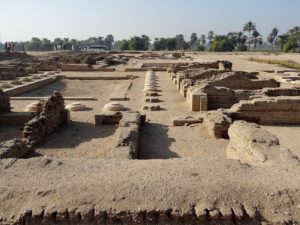
Remains of the North Palace at Tell el-Amarna. Olaf Tausch, Creative Commons Attribution 3.0 Unported license, Wikimedia Commons
_____________________________
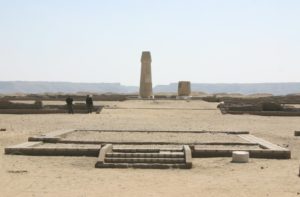
Small Temple of the Aten, at Akhetaten. Markh, GNU Free Documentation License, Wikimedia Commons
_____________________________
RM: I recall a unique image of Nefertiti in battle. And about Akhenaten – aren’t there images of him giving out necklaces? And didn’t analysis show that their people may have been starving or very low on calories?
KC: Yes. How did he get people to do what he wanted them to do? Well, he relied on the army. And secondly, he paid them off. And he’s wasn’t shy about showing it. So you see in the elite’s tombs scenes of the Window of Appearances, with the king and his bride, Nefertiti, often accompanied by their daughters, throwing gold at the people, tying the gold of honor necklace around an elite neck, essentially bribing people, paying them off, making them rich to accompany his fanatical journey. That is very clearly represented, although it has taken Egyptologists some time to see the more cynical side of that exchange.
Regarding the people (his subjects), there’s a lot of focus on that through archaeological work in Amarna now, led by Barry Kemp and his many specialists. They are examining the bodies of the laborers who built this city, comparing them to peasants’ bodies from other parts of Egypt. Forensic analysis suggests these people led a brutal existence — numerous broken bones, stress fractures in people who were too young to be working, injuries that had no time to heal; and also evidence of malnutrition, of people not having enough to eat and the right foods to eat and yet simultaneously doing this work probably at the end of a whip.
So it seems that Akhenaten was doing a lot with less and less resources as time went on. He paid off his elites with a great deal of gold. Those elites in turn wanted to keep the resources that they could, and so they didn’t let that wealth trickle down to the people who were working for them and instead ended up exploiting people quite cruelly. The scientists who examined the remains of the people who were buried in those workers’ cemeteries could see that they were treated differently than those they found in the workers’ cemeteries at Giza or Deir el-Medina, where you see stress fractures and work-related injuries but nothing like the poorly healed injuries and the evidence of back-breaking labor forced at Amarna. That was probably a nail in the coffin for Akhenaten’s fanatical religious changes.
________________________________
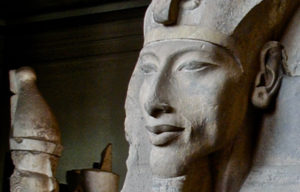
Detail, statue of Akhenaten from his Aten Temple at Karnak. Egyptian Museum of Cairo. Gérard Ducher, Creative Commons Attribution-Share Alike 2.5 Generic license, Wikimedia Commons
________________________________
Cover photo, top left: Bluesnap, Pixabay
________________________________
About the interviewer
Richard is a college teacher and author. His recent publications were in Minerva Magazine, Raven’s Perch, Paterson Literary Review and Months to Years. He has authored two books in print, Dragon Sutra and New Romantics: Ten Stories, and four books online, such as Alexander in India and NY Interviews. He, his wife Renah and daughter Inanna produce videos, the latest being Childe Hera’s World on YouTube (educational travel).
As a child, Richard was given books on history, archaeology and folklore/myth; his interests have never changed. He and his wife have traveled to sixty countries. Richard studied in Greece for a semester through New York University, from where he obtained his Ph.D. From 2002-2003 he was awarded a Fulbright to teach at LMU in Munich, Germany, as well as six NEH summer seminars, such as Andean Worlds, Transcendentalists/Concord and High Plains Indians. Richard is currently finishing up a collection of speculative stories and The Story of the Egyptian Mummy, a collection of interviews with Egyptologists about mummies.
__________________________________
Advertisement



